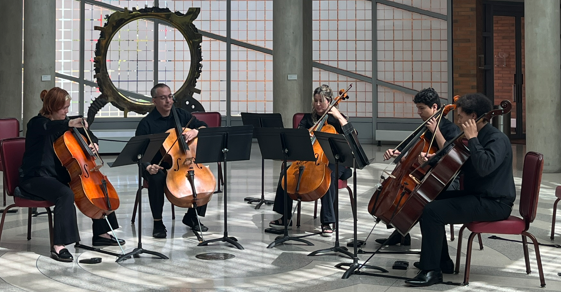
45/32
• written for Cello Quartet; 14’ 30”
( 2025 )
Video Above: the first movement, Stasis.
Program Note
45/32 is the interval ratio between the 45th and 32nd partials of the musical harmonic series. These particular pitches, when sounding together, produce a tritone, periodically (albeit not with historical accuracy) referred to as the “devil in music,” the musical interval which is generally thought of as the most dissonant. There are other relationships within the musical harmonic series that can produce the tritone, although the tuning may be slightly different.
This work was directly inspired by an academic writing that discussed in length the process of determining why 45/32 was the “best” tritone. (The tritone discussed was between F#7 and C7, the 45th and 32nd partials of the harmonic series built on C2, the lowest note of a cello’s C string.) The writing, much like a tritone itself, eventually unfolds and resolves that a dominant D7 harmony best justifies the use (and tuning) of a tritone.
This work is in three movements, each musically focused around the interval of the tritone. (Albeit an equal 600 cents from Western 12-Tone Equal Temperament, disregarding the ratio of 45/32’s ≈590 cents, or other intervals that produce a similar pitch relationship.)
The first movement is a slowly-moving, almost static landscape built around the relationship between F# and C. As the music unfolds, other pitches emerge to create harmonic context: the first movement is the D7 harmony (with embellishments) that is described by the academic text. The movement concludes with the tritone’s dissonance never resolving.
The second movement takes programmatic inspiration from the concept of a labyrinth, where individuals will make turns around walls and travel down passageways in order to find an exit. The tritone is further developed and explored in new harmonic and melodic contexts [compared to the first movement], with each cello playing their own line that overlaps the other parts. The result is an increase in tension and angst as the music becomes faster. Meanwhile, the fourth cello detunes their lowest string mid-performance to reflect the destabilizing mania. (The overall detuning spans a tritone.)
The third movement creates a new soundscape that expands upon the first two movements. The music from the first movement eventually returns and is “filled in” with the melodic mania of the second movement. The fourth cello’s lowest string is detuned to [approximately] an octave lower than where it normally would sound, barely allowing for the bow hairs to grab the string. The work ends with a bit of deception and a laugh, and a resolution that is almost perfect, but not quite. Before we know it, we'll find ourselves back at life’s tritone once again, waiting for our next moment of momentary relief and resolution.
Performances
Premiere: Sarah Rosales (cello 1), Juan Guillermo Mireles Morales (cello 2), Carolina Rodriguez de Armas & Cesar Hernandez (div. cello 3), Dalton Morris (cello 4)
(first movement only)
Sioux City, IA, August 23, 2025
on Musical World Travel recital
Sarah Rosales (cello 1), Juan Guillermo Mireles Morales (cello 2), Carolina Rodriguez de Armas (cello 3), Dalton Morris (cello 4)
(first movement only)
University of South Dakota, Vermillion, SD, September 23, 2025